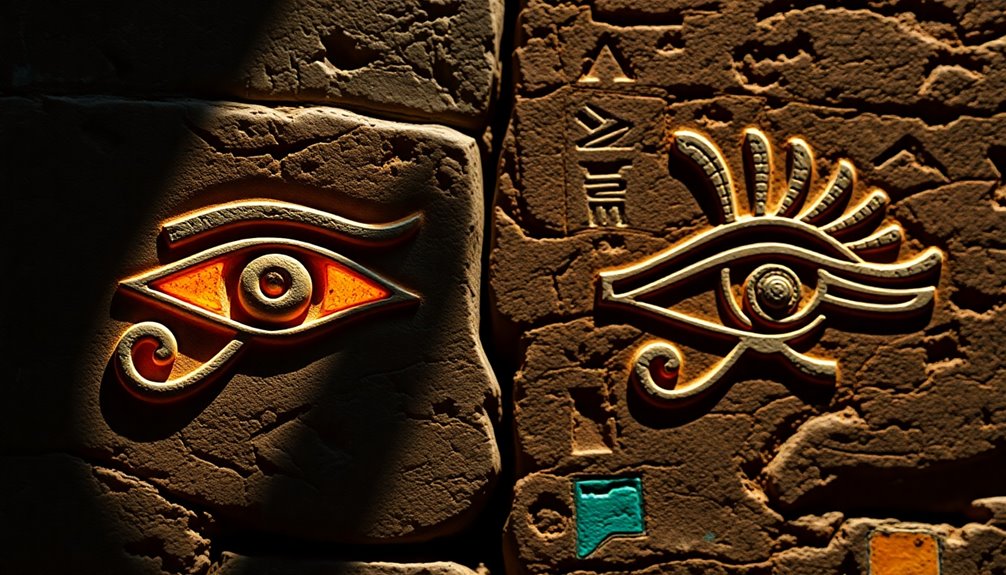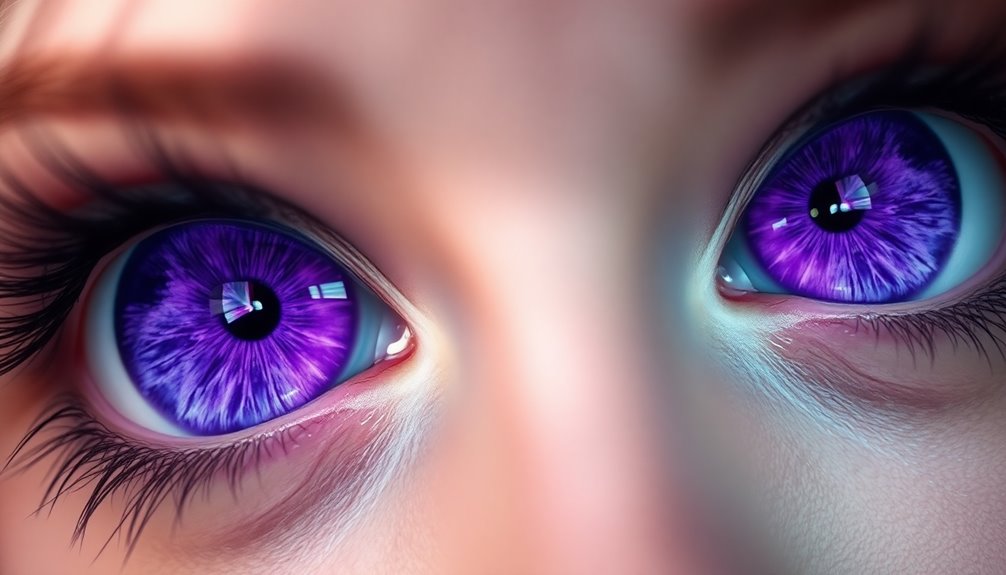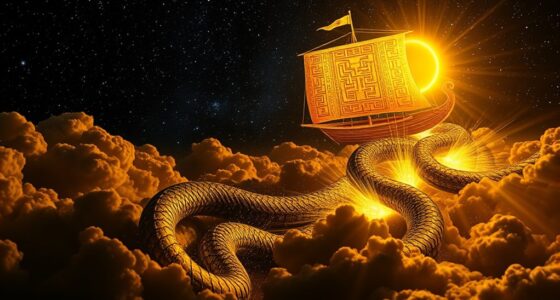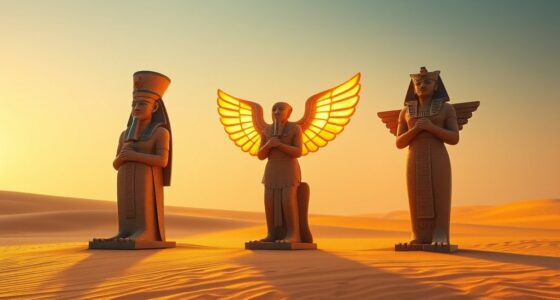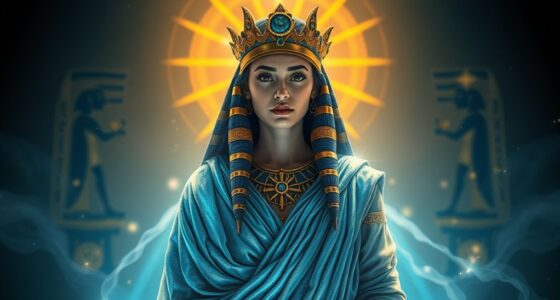The Eye of Ra and the Eye of Horus are more than just ancient Egyptian symbols; they're deeply interconnected forces. The Eye of Horus signifies healing and protection, often associated with the moon, while the Eye of Ra represents power and chaos, linked to the sun. Together, they embody the duality of existence—light and dark, chaos and order. The Eyes serve as potent amulets, reflecting beliefs about safety and strength. This balance reveals a fascinating cultural depth that might surprise you. There's much more to uncover about their myths and significance in ancient lore.
Key Takeaways
- The Eye of Horus and Eye of Ra symbolize the duality of healing and destruction, representing balance in ancient Egyptian mythology.
- The Eye of Horus, associated with protection and regeneration, contrasts with the Eye of Ra's themes of power and punishment.
- Both eyes serve as amulets, reflecting ancient beliefs about chaos and order, emphasizing their cultural significance in Egyptian society.
- Myths surrounding the Eyes depict their celestial connections, with Horus linked to the moon and Ra to the sun, embodying cosmic balance.
- The interconnectedness of the Eyes illustrates the ancient Egyptians' understanding of life's cyclical nature, blending themes of healing, protection, power, and vengeance.
Cultural Significance of the Eyes
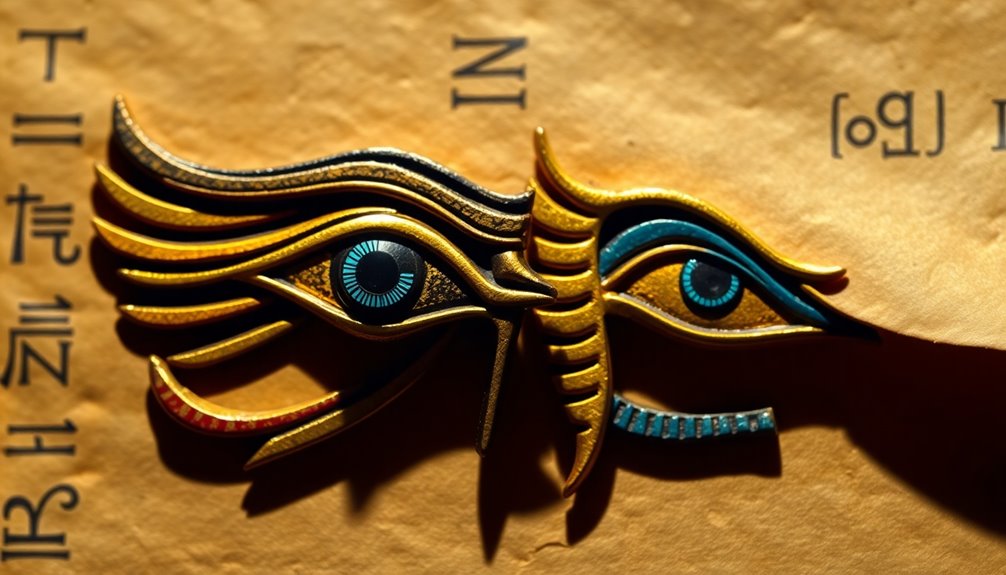
The Eye of Ra and Eye of Horus hold great cultural significance in ancient Egyptian society, embodying essential themes of protection, power, and healing. As you explore these symbols, you'll discover how they reflect the dual aspects of existence within ancient Egyptian culture.
The Eye of Horus, also known as Wadjet, represents healing and protection, stemming from the mythology of Horus avenging his father, Osiris. This eye symbolizes wisdom and restoration, offering health and safety to its bearer.
In contrast, the Eye of Ra embodies the sun's ferocity and power, often depicted as a lion. It's a symbol of royal authority and vengeance, representing the potential for destruction against enemies.
Both eyes serve as powerful amulets, illustrating the civilization's beliefs about chaos and order. The Eye of Horus, divided into six parts, signifies senses and measurements, while the Eye of Ra connects to the life-giving power of the sun and creation myths.
Together, these symbols encapsulate the rich mythology of ancient Egypt and highlight the importance of balance, intertwining protection, healing, and authority in a society that revered both aspects of existence.
Eye of Horus Explained
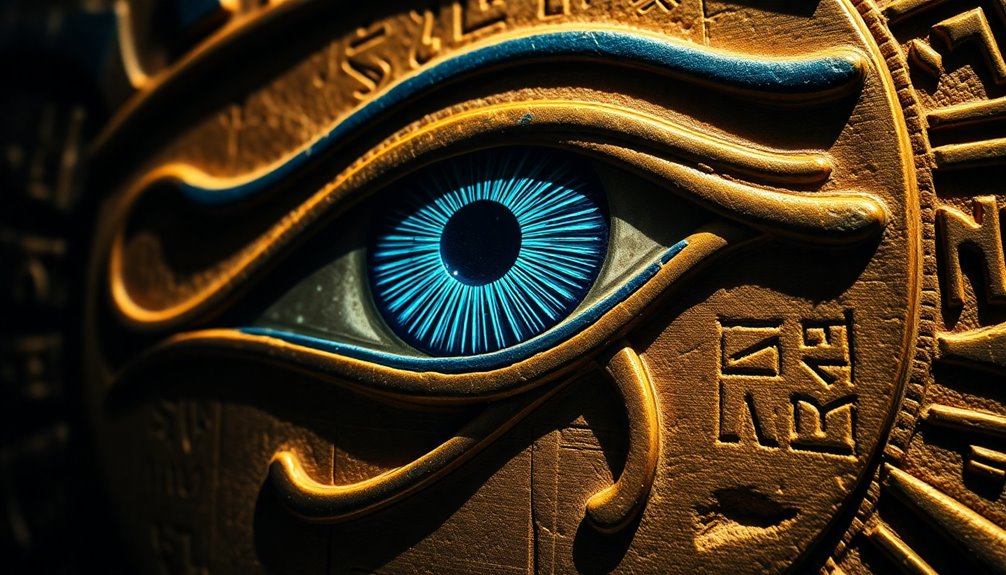
Known as the Wedjat, the Eye of Horus symbolizes healing, protection, and wisdom in ancient Egyptian culture. This powerful emblem embodies the myth of Horus avenging his father, Osiris, against the chaos-bringer, Set. The Eye of Horus represents wholeness and health, as the term "Wadjet" translates to whole or healthy.
Often depicted as the left eye of Horus, it features distinct falcon-like markings. Divided into six parts, the Eye totals 63/64, with the missing piece symbolizing imperfection or magic, linking it to the six senses.
Ancient Egyptians believed the Eye of Horus offered unparalleled protection, making it a popular choice for amulets to guarantee the well-being of wearers. The restoration of Horus's eye by Thoth after its loss in battle further emphasizes its significance.
This act symbolizes regeneration and healing, reinforcing the Eye's role in maintaining order against chaos. With its rich symbolism and connection to the divine, the Eye of Horus remains an essential part of ancient Egyptian beliefs, representing not just protection but the promise of restoration and balance in life.
Eye of Ra Explained
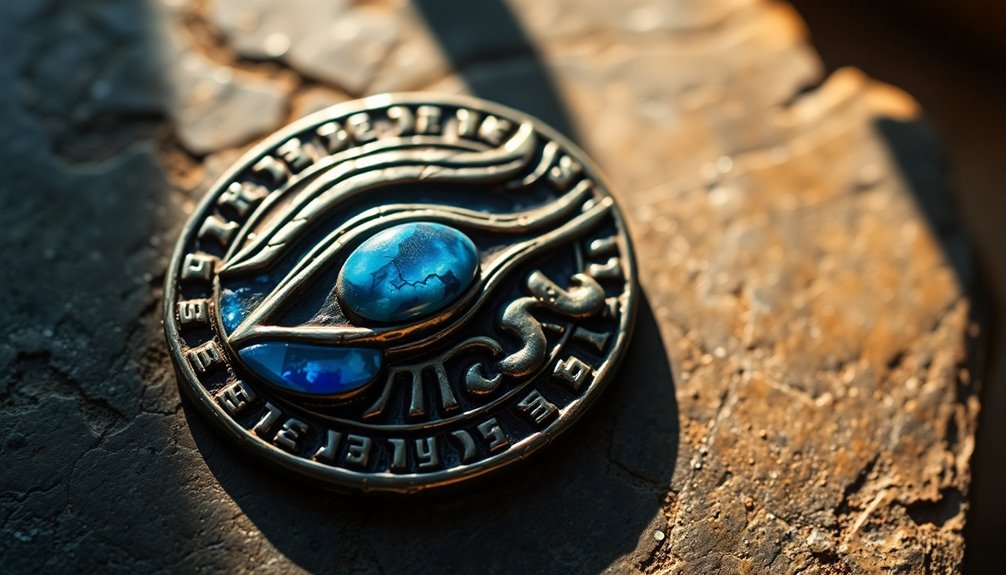
Eye of Ra Explained
Representing the right eye of the sun god Ra, the Eye of Ra embodies power, fury, and destruction. In Egyptian mythology, this symbol illustrates the duality of life and death, serving as a fierce protector while also punishing those who disrespect divine authority. The Eye of Ra is often personified as a lioness, showcasing its aggressive nature and fierce protection. This duality can be likened to the emotional dysregulation experienced in Borderline Personality Disorder, which reflects fluctuating emotional responses.
| Aspect | Description |
|---|---|
| Symbolism | Represents power and divine authority |
| Goddess Connection | Linked to Sekhmet, Hathor, and Bastet |
| Destructive Nature | Punishes humanity for transgressions |
| Nurturing Side | Calmed by beer and pomegranate juice |
| Art Representation | Often depicted with a sun disk or cobra |
The ancient Egyptians revered the Eye of Ra not just as a symbol of destruction but as a source of life, reflecting the sun's nurturing qualities. It played an essential role in protecting the pharaoh and the nation, embodying both the ferocity and safeguard of the sun god Ra. Through its rich symbolism, the Eye of Ra continues to fascinate and inspire. Additionally, the importance of content quality is reflected in how the Eye of Ra has been interpreted and represented throughout history.
Comparing the Two Eyes
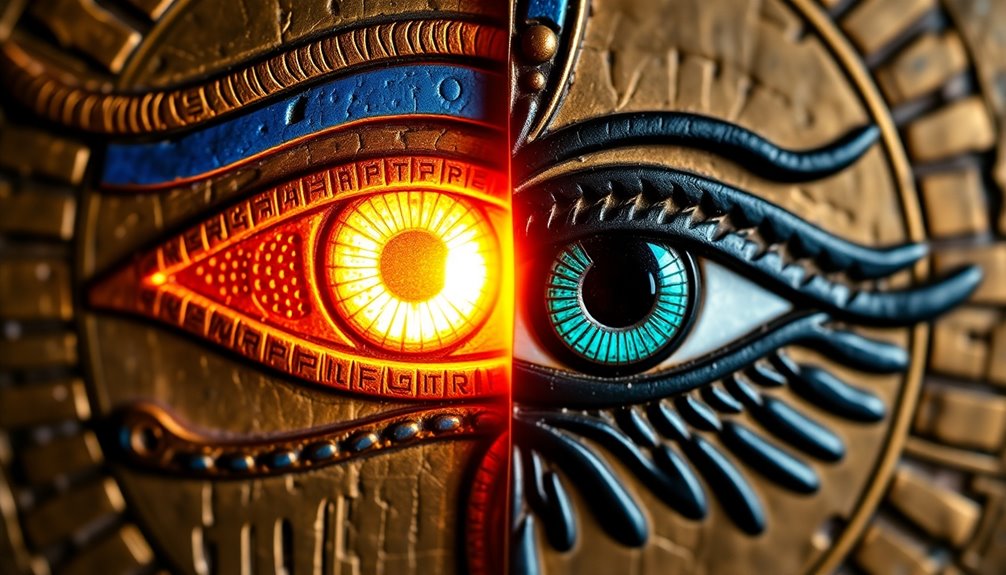
In ancient Egyptian mythology, the Eye of Ra and the Eye of Horus serve as powerful symbols that embody contrasting yet complementary forces. The Eye of Ra, represented as the right eye, symbolizes power, fury, and destruction. It's linked to Ra's daughter, who punishes humanity for disobedience.
On the other hand, the Eye of Horus, depicted as the left eye, embodies healing, protection, and wisdom. Known as the Wedjat, this eye is associated with Horus avenging his father, Osiris.
Both symbols play significant roles in ancient Egyptian art and jewelry, yet they convey different cultural significances. The Eye of Horus is often seen as a protective amulet, while the Eye of Ra communicates authority and vengefulness.
Notably, the Eye of Horus is divided into six parts, symbolizing wholeness and health, contrasting with the Eye of Ra's connection to the sun's destructive force, often depicted with a cobra for added protection.
Despite their differences, the Eye of Ra and the Eye of Horus represent dual aspects of existence—healing versus destruction and protection versus punishment—showcasing the rich tapestry of Egyptian mythology.
Celestial Connections and Symbolism

As you explore the celestial connections between the Eye of Ra and the Eye of Horus, you'll notice how these symbols embody the balance of light and darkness.
Each eye represents different aspects of existence, shaping ancient beliefs about their roles in the cosmos.
This duality highlights the significance of both celestial bodies in Egyptian mythology, influencing how they viewed the protective powers of these divine symbols.
Celestial Bodies and Mythology
Celestial harmony plays an essential role in ancient Egyptian mythology, where the sun and moon are personified through the Eyes of Ra and Horus. The Eye of Ra, representing the sun, embodies dominance and fierce protective power, while the Eye of Horus symbolizes the moon, linked to healing and restoration. This duality reflects the balance of celestial influences that shapes the universe.
| Aspect | Eye of Ra | Eye of Horus |
|---|---|---|
| Celestial Body | Sun | Moon |
| Symbolism | Authority and Protection | Wisdom and Healing |
| Role | Life-giving and Destructive | Regeneration and Balance |
| Mythological Link | Fierce solar deity Ra | Lunar cycles and healing |
| Cosmic Order | Maintains order and light | Restores balance and peace |
In ancient Egyptian religion, these celestial connections were vital. The movements of the sun and moon were believed to influence earthly events, emphasizing the importance of the Eye of Ra and the Eye of Horus in maintaining cosmic order and harmony. By understanding their roles, you explore deeper into the profound symbolism within this ancient belief system.
Symbolism of Light and Darkness
The interplay between light and darkness in ancient Egyptian mythology reveals profound insights into the culture's understanding of existence. The Eye of Ra symbolizes the sun, embodying light, power, and divine authority, while the Eye of Horus represents the moon, signifying healing, protection, and wisdom. This celestial connection highlights the importance of both light and darkness in their beliefs.
The fiery nature of the Eye of Ra is often associated with destruction and punishment, contrasting sharply with the Eye of Horus, which serves as a protective force against chaos and evil. Together, these symbols depict a harmonious balance, reflecting the duality of life.
The Eye of Horus is deeply linked to regeneration, representing the moon's phases and the cycle of restoration. In contrast, the Eye of Ra represents the sun's all-seeing power, emphasizing the complementary roles of these celestial bodies.
Each eye serves not just as a symbol of its respective deity but also as a metaphor for the cyclical nature of existence, with the Eye of Ra representing day and the Eye of Horus symbolizing night—together, they encapsulate the eternal dance of light and darkness.
Duality in Ancient Beliefs
In ancient Egyptian beliefs, duality plays a crucial role, especially in the interplay between the Eye of Ra and the Eye of Horus. These symbols reflect celestial connections within their cosmology, embodying contrasting yet complementary forces. The Eye of Ra, representing the sun, signifies power and punishment, while the Eye of Horus, linked to the moon, embodies protection and healing.
| Eye of Ra | Eye of Horus |
|---|---|
| Power and authority | Protection and health |
| Destruction | Regeneration |
| Vengeful nature | Wholeness and restoration |
The duality between these two eyes showcases a balance essential to ancient Egyptian life. The Eye of Horus is associated with themes of regeneration, representing order restored after chaos. Conversely, the Eye of Ra reflects a fierce force, emphasizing the delicate line between creation and annihilation.
These symbols were frequently used in amulets, where the Eye of Horus offered healing and protection, while the Eye of Ra provided strength. Together, they illustrate the intricate symbolism found in ancient Egyptian culture, revealing the deep understanding of duality woven into their beliefs.
Myths Surrounding the Eyes
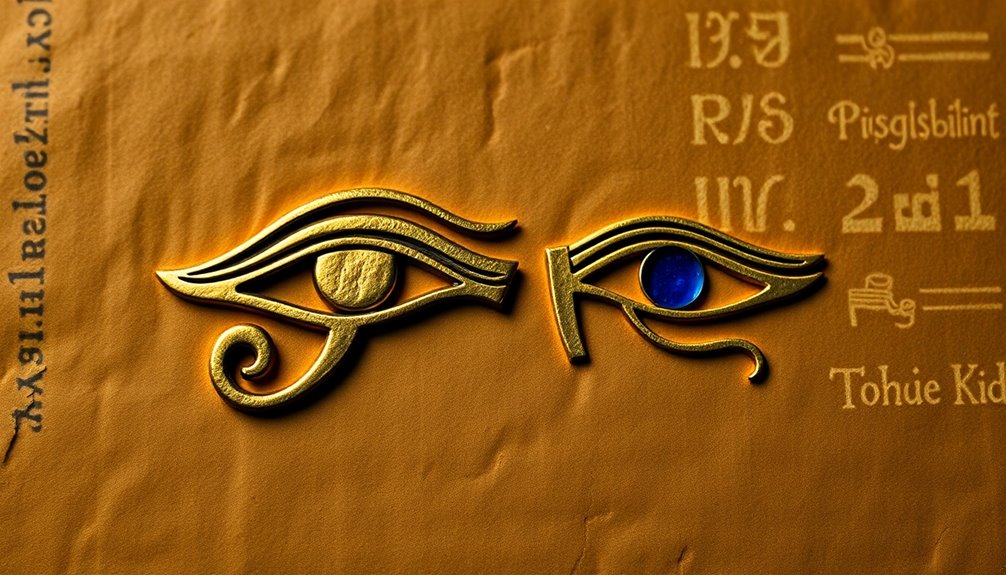
When you explore the myths surrounding the Eye of Ra and the Eye of Horus, you'll notice a striking duality of power.
The Eye of Ra emerges as a force of chaos and punishment, while the Eye of Horus embodies healing and protection.
These contrasting narratives reveal the ancient Egyptians' understanding of creation and the balance between destruction and restoration.
Duality of Power
Throughout ancient Egyptian mythology, the Eye of Ra and the Eye of Horus represent the duality of power, illustrating how destruction and healing coexist. The Eye of Ra, embodying the sun, showcases a destructive force that punishes humanity for disobedience. In contrast, the Eye of Horus symbolizes healing and protection, reflecting resilience and restoration. This balance between the two is pivotal in understanding their roles as protective symbols.
| Symbol | Representation | Role in Myths |
|---|---|---|
| Eye of Ra | Destruction, Wrath | Punishes disobedience |
| Eye of Horus | Healing, Protection | Restores Horus's lost eye |
| Deities | Ra and Horus | Balance between wrath and compassion |
| Resilience | Eye of Horus | Horus avenges Osiris |
| Duality | Coexistence of forces | Creation and destruction in life |
These legends reflect the ancient Egyptians' understanding of balance in life. While the Eye of Ra instills fear, the Eye of Horus offers safety, showcasing how both aspects of power are essential to the human experience.
Creation Myths Explained
While exploring the creation myths surrounding the Eye of Ra and the Eye of Horus, you'll uncover fascinating stories that reveal their distinct attributes and roles.
The Eye of Ra was created by the goddess Hathor as a weapon to punish humanity for their disrespect toward Ra. This illustrates its fierce nature, embodying destruction and chaos.
In stark contrast, the Eye of Horus represents healing and restoration. This stems from the myth where Thoth restores Horus's left eye after it was lost in his battle against Set.
These creation myths emphasize a duality in their characteristics. The Eye of Ra, often depicted as a lioness, signifies the violent aspect of divinity. Meanwhile, the Eye of Horus, associated with a falcon, symbolizes clarity and insight.
Both eyes intertwine within the creation narratives, linking the Eye of Ra to the sun and the Eye of Horus to the moon. This connection highlights the ancient Egyptians' understanding of celestial bodies and their profound influence on life and order.
Ultimately, these myths provide a rich tapestry of meaning, illustrating how the Eyes reflect the balance of healing and destruction in the cosmos.
Frequently Asked Questions
What Is the Meaning of the Eye of Horus and the Eye of Ra?
The Eye of Horus symbolizes healing, protection, and wisdom, reflecting balance and restoration in your life.
On the other hand, the Eye of Ra represents power, fury, and destruction, illustrating a more vengeful aspect of divine authority.
Together, these symbols embody the duality of protection versus punishment in ancient Egyptian culture.
What Is the Eye of Horus Teardrop?
The Eye of Horus teardrop is like a river of emotions flowing from the divine.
This downward curve symbolizes healing and compassion, connecting you to ancient Egyptian beliefs. It represents the "eye of the heart," emphasizing emotional intelligence.
In jewelry and art, it serves as a protective element, reminding you of Horus's battle and resilience.
This teardrop reflects life's duality, embodying both sorrow and healing, reinforcing the importance of wholeness and health.
What Does the Bible Say About the Eye of Horus?
The Bible doesn't mention the Eye of Horus directly, but it warns against idolatry and pagan practices that this symbol represents.
When you look at verses like Exodus 20:3-5, it's clear that worshiping false gods is discouraged.
While the Eye of Horus symbolizes protection in Egyptian mythology, the Bible emphasizes relying on God for true protection and healing, as seen in Psalms 91:11-12.
What Does 𓂀 Mean?
The symbol 𓂀, known as the Eye of Horus, stands for healing, protection, and wisdom.
It's a powerful emblem in ancient Egyptian culture, often tied to the myth of Horus avenging his father, Osiris.
You'll notice that it's divided into six parts, which adds to its unique significance.
In contrast, the Eye of Ra symbolizes the fierce power of the sun and serves as a protective and aggressive force against disobedience.
Conclusion
In exploring the Eye of Ra and the Eye of Horus, you uncover a rich tapestry woven with cultural significance and celestial connections. These symbols, like twin stars in the night sky, illuminate ancient beliefs and myths that still resonate today. By understanding their meanings, you not only gain insight into Egyptian mythology but also connect with a timeless legacy that continues to captivate our imagination. Embrace this knowledge, and let it guide your journey through history's vibrant landscape.

